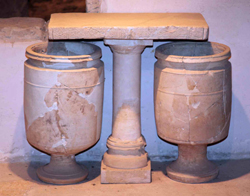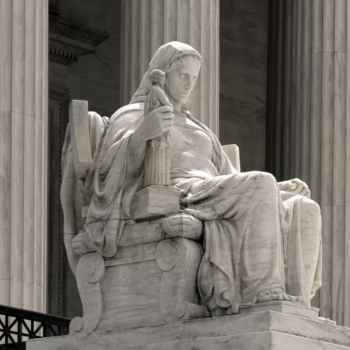The wedding is apparently at the home of a wealthy family in Cana, near Nazareth. Their wealth is reflected in the fact that they have six large stone water jars (2:6); ordinary people in the first century used clay water jars since stone jars were quite expensive. Archaeologists have uncovered such stone vessels in a wealthy priest's home in Jerusalem—now accessible in the Wohl Museum in the Jewish Quarter (see photo). If the wedding was for one of Jesus' relatives, it may indicate that Jesus' family was fairly well-to-do, since Jews in first-century Palestine tended to marry in their same social class.
 According to the Torah, clay vessels that became ritually impure needed to be broken (Lev. 11:29-38). Later Jewish tradition, however, held that stone vessels did not become impure through contact with impurities (Mishnah, Betza 2.3), and hence were far superior for maintaining a state of purity in a household. The presence of six large stone purification vessels, each holding 20-30 gallons of water (2:6), indicates the wedding was at a household concerned with ritual purity. It is possible they were priests, since stone vessels were most closely associated with priestly clans.
According to the Torah, clay vessels that became ritually impure needed to be broken (Lev. 11:29-38). Later Jewish tradition, however, held that stone vessels did not become impure through contact with impurities (Mishnah, Betza 2.3), and hence were far superior for maintaining a state of purity in a household. The presence of six large stone purification vessels, each holding 20-30 gallons of water (2:6), indicates the wedding was at a household concerned with ritual purity. It is possible they were priests, since stone vessels were most closely associated with priestly clans.
At an even more speculative level one can ask if Mary's family may have had priestly connections. Elizabeth, the wife of the priest Zechariah, was said to be of the "daughters of Aaron" (Lk. 1:5), and was also a "relative/kinswoman" (suggenis) of Mary (Lk. 1:36). If this tradition is authentic, it would mean that Mary must have had a priestly lineage, presumably through her mother, and thus had relatives that were priests. If these hints are properly interpreted here, then the wedding at Cana may have been of these priestly relatives of Mary, which would explain the presence of six huge stone vessels for purifications.
All of this is speculative, however, and distracts from the real point of the story: Jesus changes water into wine. John calls this "the first of his signs," which "revealed his glory" (2:11). Unlike most later public signs in John, this one is done privately, so that only his disciples and the servants know what was done (2:9, 11). And the result of this sign is expressly stated: "his disciples believed in him" (2:11). Furthermore, unlike all of Jesus' subsequent public signs, no symbolic meaning is given for this sign.
The fact that John does not ascribe any symbolic meaning for this sign has not prevented scholars from trying to find one. When examined in conjunction with the multiplication of the loaves of bread in John 6, we see signs involving the miraculous creation of wine or bread. This may hark back to priest-king Melchizedek offering bread and wine to Abraham (Gen. 14:18); Jesus, as the new Melchizedek-like High Priest (Heb. 7), likewise offers bread and wine to the descendants of Abraham. Some think it may point forward to the bread and wine of the Last Supper. However, although all the Synoptic Gospels describe Jesus' eucharistic prayer at the Last Supper (Mt. 26:26-29; Mk. 14:22-25; Lk. 22:15-20), John's Gospel has no account of a proto-eucharistic ritual during the Last Supper (but see Jn. 6:55-56), so it is unlikely that he had this in mind. Later Christians, however, certainly saw these two miracles as prototypes of the wine and bread of the Eucharist. Unlike the sermon on the bread of life (Jn. 6), however, Jesus makes no theological discourse explaining the meaning of changing water into wine. He does, however, eventually discuss the Messianic symbolism of the vine (Jn. 15:1-17), which may be indirectly connected to this sign.
There were also Jewish traditions that the coming of the Messiah would usher in an age of abundance, symbolized by wine flowing like water (Am. 9:11-14; Jl. 2:24, 3:18). Inter-testamental sources exhibit the same expectation, with vines yielding prodigious amounts of grapes (2 Bar. 29:5; 1 Enoch 10:19). Some scholars also see this miracle as related to the Messianic banquet, that is, a great eschatological feast to which all the nations will be welcomed. The foundation of this idea is Isaiah 25:6, and it is developed in Luke 13:29, Revelation 19, and Jesus' parable of the wedding feast (Mt. 22:1-14; Lk. 14:15-24). However, this eschatological feast is not a major theme in John.
First-century Jews, however, would have been more likely to associate the religious symbolism of bread and wine with the temple offering of the twelve loaves of the bread of the presence (KJV: shewbread) (Ex. 25:23-30; Lev. 24:5-9), and the regular temple wine libations (drink offerings) (Num. 29; Ex. 29:38-41; Lev. 23:13). New wine was also to be brought to the temple as a first fruit offering (Num. 18:12). Just as Jesus had been immersed as a purification rite in preparation for purifying to the temple, this new wine may have been seen as the Messiah's first fruit offering for the nation of Israel. Thus both the baptism of Jesus and the miracle of the wine were preparation for Jesus' purification of the temple in John 2:13-25.
A pdf of the full version of this column, with extensive references and notes, can be found here.
Updates and discussion can be followed on Facebook.





